| 24-70mm |
$1,170 average price |
|---|---|
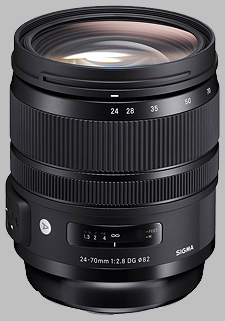
|
|
Your purchases support this site
Canon EF - Black
Updates:
08/10/2017: Field Test & Gallery added
Sigma 24-70mm f/2.8 OS Art Field Test
Should you pick up this hotly-anticipated zoom?
by Jaron Schneider | Posted 08/10/2017
 |
|
Canon 5D Mark III: 70mm, f/2.8, 1/50s, ISO 1250
This image has been edited. Please click for the original. |
Going into this review, it would be an understatement that I and those interested in the Sigma 24-70mm f/2.8 Art had high expectations for it. The previous Sigma 24-70mm f/2.8 was no slouch, the new Tamron 24-70mm f/2.8 is pretty good, and then the latest 24-70mm f/2.8 lenses from both Nikon and Canon are outstanding (our friends at LensRentals actually say the Canon is the best of the bunch, but I know many Nikon fans who would happily jump in and disagree). Suffice it to say, Sigma is not coming into this fight attempting to fix a "problem" like they did with their first "Art"-series lens, the 35mm f/1.4 Art. Before this new Art lens, the market already housed at least two spectacular 24-70 lenses and a few other good ones. In order for Sigma to really make a splash, they would have to either equal or outperform Nikon and Canon, and then also come in at a lower price point. Further, this is a task they have not shied away from in the past, and have repeatedly accomplished. So to say that this was the minimum expectation of the 24-70mm f/2.8 Art for me and for just about any prospective buyer is not overreaching -- it most certainly was.
So anything less than truly outstanding performance would be a disappointment. That casts an odd angle of judgment of this lens, because it may put the Sigma in a realm of "unattainable" when it comes to testing. That's not particularly fair for Sigma. So to be fair, I'll do my best to remove those expectations from this optic and instead look at what it accomplishes.
 |
Canon 5D Mark III: 24mm, f/2.8, 1/50s, ISO 1250 This image has been edited. Please click for the original. |
The Sigma 24-70mm f/2.8 Art continues the same overall design and handling that is to be expected of the updated lenses under Sigma's Global Vision. The jet black design, the same familiar feel to the focus and zoom rings, and the same expectedly heavy weight make this lens fit perfectly alongside its brethren.
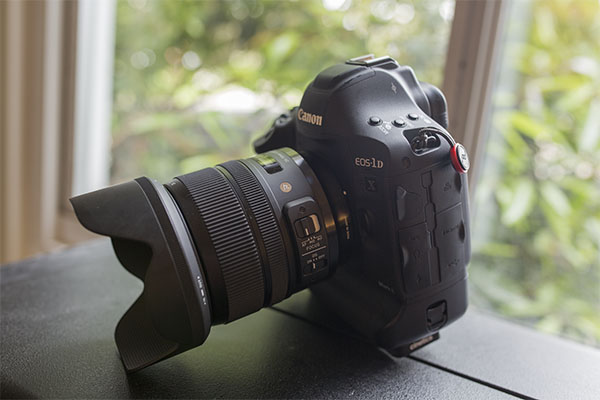 |
Holding the lens in hand, like the other Art lenses before it, quality is immediately apparent. Everything about the lens feels high-end, from the way the focus rings turn to the clean, satisfying way the different mode buttons click into place and the crispness of the connection between the front element and the lens hood -- everything feels as good as it possibly could. This should come as no surprise though, as high quality look and feel is one of the staples of Sigma's Global Vision. The 24-70mm f/2.8 is simply the latest optic to embody that image.
Speaking specifically to weight, like nearly all the Global Vision lenses and especially those in the Art line, the 24-70mm is heavy. Like, very heavy. As in, it tips the scales at a hefty 2.24 pounds (1.01 kilograms) in addition to whatever your camera body weighs. My main camera is the Canon 1DX Mark II, so you can imagine how hefty this combination is.
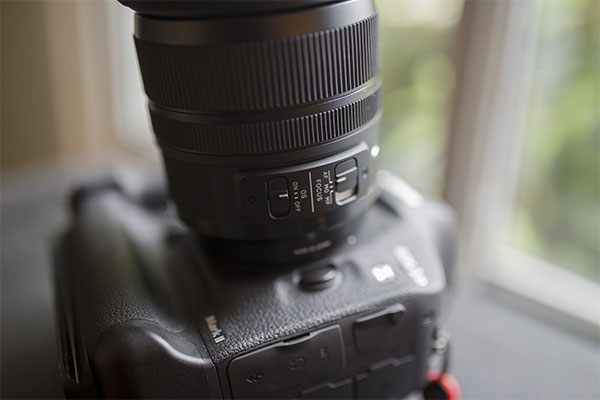 |
In two separate instances during testing, that weight became a burden. I shot for about 20 minutes in a swimming pool and an hour in a helicopter. In the pool, I had to keep the camera above the water line the entire time for obvious reasons, and the sheer weight of the camera and lens combination really started to take its toll. Near the end of that session, I was absolutely not enjoying holding my camera anymore. In the helicopter, maneuvering the camera/lens combo was just as tedious, and after the flight I was exhausted (more so than usual when shooting out of a helicopter).
For comparison purposes, the new Nikon 24-70mm f/2.8E VR lens weighs 2.4 pounds, and the Canon 24-70mm f/2.8L II weighs 1.7 pounds. For Nikon folks, the NIKKOR lens surprisingly weighs even more, but the Canon weighs considerably less.
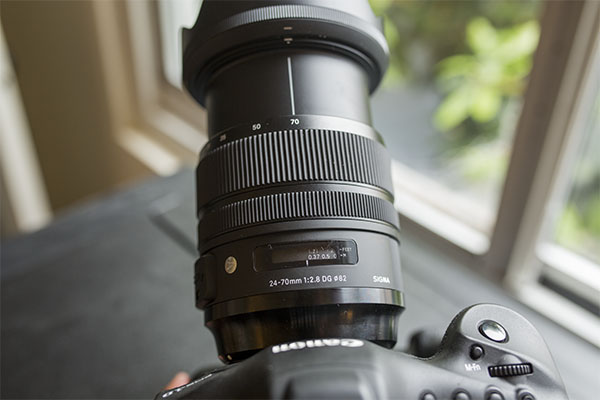 |
The focus ring is located behind the zoom ring; the location of focus vs zoom rings is regularly swapped depending on who makes the lens. The last set of Sony, Canon and Nikon lenses I have tested are all the opposite of this Sigma. Is this a problem? Not really. Just something to note. It is worth pointing out that this focus ring, though much larger than the one on the Sigma 24-105 f/4 Art, is still pretty thin. It's about half the width that you are probably used to on lenses of this size, which some may dislike. I think it's just wide enough to not cause issue with a majority of photographers, and I'm glad they did not keep it as slim as the one on the 24-105mm, which is generally regarded as being extremely too thin.
I wanted to take a second to go over a new focus mode on the Sigma 24-70mm f/2.8 Art that you perhaps would be unfamiliar with: Manual Override (MO). Though both the Autofocus (AF) and Manual Focus (MF) work as expected, Sigma added a third focus mode that gives you more control in very specific instances. Manual Override mode cancels continuous autofocus when you adjust the focus ring. More specifically, if you're half pressing the shutter button in continuous autofocus mode, you can keep half pressing and adjust the focus ring and the lens will not attempt to autofocus unless you release the shutter and half press it again. In Autofocus mode, moving the manual focus ring while holding a half press doesn't stop the continuous autofocus from attempting to re-engage. Of course, any time you rotate the focus ring, you can adjust focus, even in regular AF mode.
What is the use case? It's pretty specific. If you want to try and get focus but the camera is not quite continuously focusing where you want, Manual Override would allow you to maintain a half press while doing a small manual adjustment, then finish the shot by fully pressing the shutter button without worrying that the lens would attempt to re-acquire the wrong focus point again.
Think of it a bit like rear-button autofocus. That's the closest comparison I can make, except this is directly on the lens instead of making a change to the camera's custom functions.
The MO function can be further customized using the Sigma Dock.
 |
Canon 1D X Mark II: 24mm, f/5.6, 1/100s, ISO 200 |
Sigma included their Hyper Sonic Motor (HSM) in the 24-70mm, and it does focus extremely quickly and accurately, albeit a bit loudly. The noise of the focusing motor is especially obvious during video using continuous autofocus. Though it's not extreme, it is certainly louder than I was expecting.
Speaking of continuous autofocus in video, I was pretty impressed with how well the lens performed here. Outside of the noise of the focusing motor, the lens was able to keep up with the demands of the Canon 1DX II's Dual Pixel Sensor, and tracked focus extremely well.
I feel like I should mention the number of things Sigma has done to their optics inside the lens, as well as how many elements it has (19!). The lens includes three SLD elements and four aspherical elements, which aim to reduce distortion, aberrations, color fringing, and other anomalies. A Super Multi-Layer Coating has also been applied to reduce lens flare and ghosting, and a protective coating has been added to the front element, too.
Chromatic Aberration
In looking at images I took, I can't argue that the coatings and elements Sigma employs here didn't do their job. I don't see much in the way of chromatic aberration or flaring, even when shooting shiny objects framed by the sun, or shooting extremely back lit. In a couple photos I noticed some extremely minor chromatic aberration along edges of contrast points, but this was only after deeply inspecting an image looking for it. I was literally pixel peeping, but I can confirm some does exist.
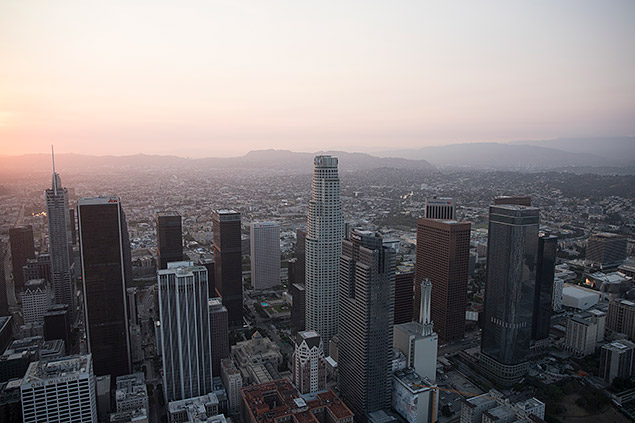 |
Canon 1D X Mark II: 33mm, f/4.5, 1/1000s, ISO 800 |
600% magnification |
In straight-up testing, I tried to make chroma happen. Below you can see four 100% crop samples from the series (all three at f/2.8 where chromatic aberration is more likely to happen), and you can peruse the entire set for yourself in the gallery.
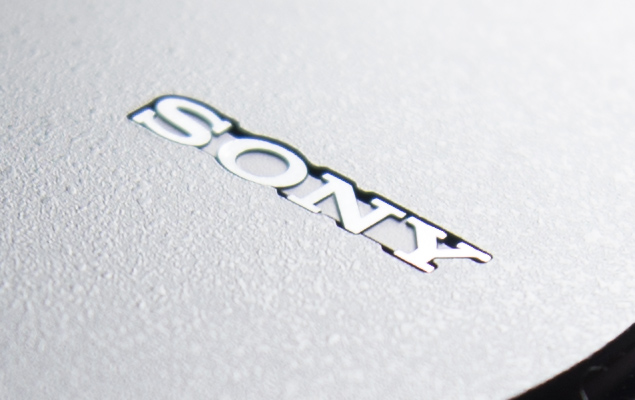 |
24mm, f/2.8 |
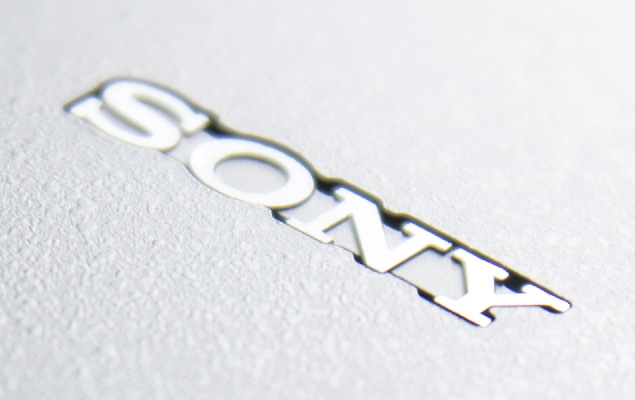 |
35mm, f/2.8 |
 |
50mm, f/2.8 |
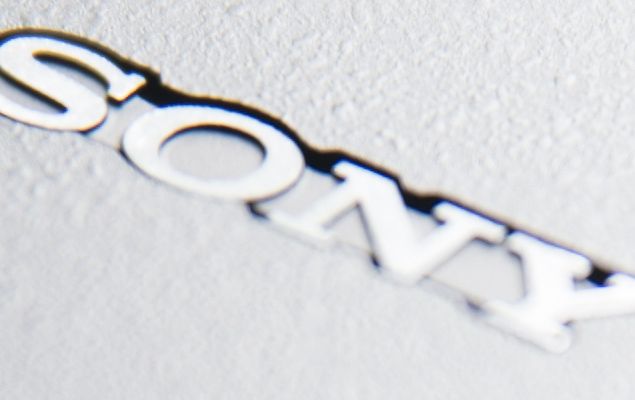 |
70mm, f/2.8 |
You can see that there is some purple and green fringing, but I do not think it is terrible and it is easily fixed in post. Additionally, chromatic aberration basically disappeared at 70mm.
Flaring
Flaring was extremely well controlled, and I didn't see any that compromised my images.
 |
Canon 1D X Mark II: 70mm, f/5.6, 1/2000s, ISO 200 |
Vignetting
As for vignetting, for those who like optical perfection, unfortunately this lens has a lot of it. It's not as severe as what can be witnessed in Sigma 35mm f/1.4 wide open, but it's far more pervasive. At every focal length and at every aperture, some level of vignetting was visible. Below are samples of the worst of it at f/2.8:
 |
24mm |
 |
35mm |
 |
50mm |
 |
70mm |
Through the entire zoom range and across all the apertures, the 24-70mm f/2.8 has some level of vignette. Though it doesn't bother me as a reviewer or as a photographer, it is worth pointing out. It is, as expected, heaviest at f/2.8. It does dissipate rather quickly though, and it becomes relatively unnoticeable past f/5.
 |
Canon 5D Mark III: 54mm, f/2.8, 1/50s, ISO 1250 This image has been edited. Please click for the original. |
At 24mm:
Wide open at f/2.8, you are going to find the Sigma giving the best performance in the center of the frame. All along the outside of that center area, the lens' sharpness falloff is rather steep. By the time you get to the corners, the blurring is extremely severe.
Compare the corner:
To the center:
The good news? That sharpness starts to clean up quickly. By f/4, the corner blurring is far less noticeable, and it's pretty much a non-issue by the time you are up to f/5.6. Even better, the overall sharpness through the aperture range at 24mm is really consistent. Even f/22, though suffering a bit of diffraction, looks really good and only a little less sharp than f/2.8 and f/5.6.
Here is a 100% crop of the center at f/5.6:
Versus the center at f/22:
At 35mm:
35mm has the same corner sharpness problems that 24mm does, but to a lesser degree. While I think that overall sharpness is crisper (and the center of the frame does look quite sharp), the edges are still problematic.
Compare the corner:
To the center:
Outside of the sharpness test images I shot, I took a look at some of the other images I shot in a real-world situation, and noticed that it's not always just the typical edges of the frame that can become blurred, but anything outside a certain radius of my focus point. For example, in this picture of a pier in Santa Monica:
 |
Canon 1D X Mark II: 65mm, f/5.6, 1/100s, ISO 200 |
You should notice that more than half the image has a blurriness problem, even the dead center of the frame. In fact, if you didn't scroll up to the right quarter of the image, you might even think the entire thing is barely out of focus. But the point that I focused on is quite crisp. So the Sigma 24-70mm Art might have a sharpness falloff issue that is totally independent of the corners, but related specifically to distance from a focus point.
But again, the good news is that at f/5.6 and until f/22, sharpness consistency evens out nicely. And like at 24mm, even f/22 looks pretty good. Even better, because overall sharpness is improved at the 35mm focal length over 24mm, images look nicer and sharper across the board.
At 50mm:
The same problems evident at 24mm and 35mm are present at 50mm: sharpness falloff at more open apertures at the corners.
Corner at f/2.8:
Versus Center at f/2.8:
The sharpness falloff is definitely less severe than at 35mm and especially what we saw at 24mm, but it's still evident. Again though, sharpness really evens out around f/5.6 and images look really good again up to the max of f/22.
Corner at f/5.6:
Versus corner at f/22:
Conversely, the sharpness at the center of the frame is pretty consistent through the aperture range. Take a look at the center of an image shot at f/2.8:
Versus one shot at f/5.6:
Versus one shot at f/22:
See a major sharpness difference? I don't, and that's pretty impressive.
 |
Canon 1D X Mark II: 50mm, f/2.8, 1/500s, ISO 125 This image has been edited. Please click for the original. |
In real-world photos, I feel like the images produced look good, but there is nothing outstanding about the crispness of the image. It's certainly quite good, and my subjects are always in focus and sharp, but they don't jump off the page like I'm used to seeing with Sigma lenses.
At 70mm:
At 70mm, the Sigma does it's best work. Corner sharpness is much more consistent with center sharpness, and overall images are much cleaner.
Corner at f/2.8:
Versus the center at f/2.8:
As for overall sharpness here, let's take a look at how the center fares across the aperture range:
At f/2.8:
At f/5.6:
At f/10:
At f/22:
At f/22, if you look closely you can see the image gets just a bit fuzzier when compared to the other three samples, but it's still a very fine performance. If the rest of the focal lengths performed as well as it does at 70mm, we would have an exceptional optic on our hands.
Sharpness Overall:
I don't think this should be understated: it's quite unusual to see narrow aperture performance as good as what the Sigma 24-70mm f/2.8 Art has through the zoom range. Sharpness is very good, and even though there is indeed a sweet spot for sharpness in this lens (I personally liked f/9), f/22 for the most part is marginally different from that spot.
I think the lens does quite well at 35mm through around the 50mm range, with 24mm being the weakest, especially wide open. Trumping them all however is 70mm, with the best corner-to-corner sharpness performance through the zoom and aperture range. This confirms the MTF charts for this lens, which show that 70mm is the strongest focal length with 24mm being the weakest.
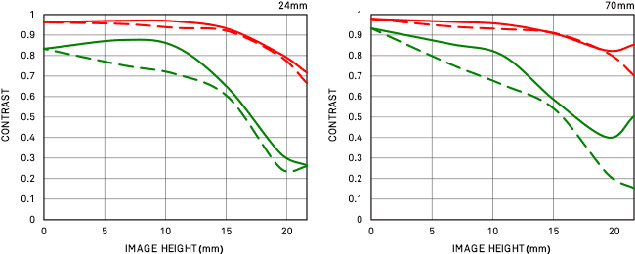 |
Diffraction |
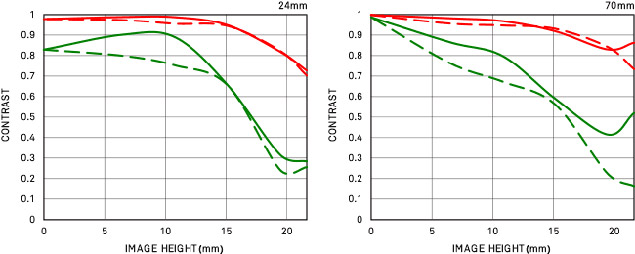 |
Geometrical |
The takeaway here is that although sharpness may be relatively consistent at each focal length through the aperture range, sharpness quality overall is not consistent through the focal length range.
The 24-70mm f/2.8 is often described as most folks' "desert island" lens. It's an optic that is the definition of utility, being good for just about anything. Though it's rare to find one that truly excels at everything, most 24-70mm lenses are perfectly capable optics that can handle a wide range of tasks.
That's certainly the case with the new Sigma 24-70mm f/2.8 Art. I used it in portrait photography, street photography and aerial landscape photography and found it to be pretty solid in all cases. Handling, autofocus speed and accuracy, and overall feel of the lens is without issue. Physically, it works extremely well.
My only real complaint through real-world testing is that the sharpness inconsistency did cause one of my favorite shots from the helicopter flight to be "ruined." It's not really ruined by any means, but I can see a definite sharpness difference between the center of the frame, and the bottom, even when I'm not viewing it at 100%. Compared to my other aerial shots I've taken over the years, this inconsistency would stand out.
 |
Canon 1D X Mark II: 70mm, f/5.6, 1/100s, ISO 200 This image has been edited. Please click for the original. |
What I liked:
- Great build quality
- Smooth, stiff, and crisp focus and zoom rings
- Optical stabilization
- Nifty "Manual Override" autofocus mode
- Excellent image quality retention even at maximum aperture
- Great chromatic aberration and flaring control
- Autofocus is quick, accurate and works well with continuous autofocus in stills and video
- Good price point
What could use improvement:
- Overall sharpness is lackluster
- Corner, or even edge, sharpness lacking at all but 70mm focal lengths
- Vignetting
- Autofocus motor is a little noisy
- Lens is very heavy
Sigma 24-70mm f/2.8 Art Field Test Summary
It's weird to write a review of a Sigma lens where I have concerns about sharpness, but with the Sigma 24-70mm f/2.8 Art, it's the number one thing on my mind. It would be more forgivable if the lens simply wasn't as sharp as I am used to seeing out of Sigma, but unfortunately it's not just that: it's that edges and corners suffer from sharpness falloff at all focal lengths at brighter apertures to the degree that I can notice it even in images not at 100% magnification. It's awesome that the lens looks great at f/16 or even f/22, but it's far more rare to shoot that stopped down.
So the challenging thing to consider is if you are willing to take a lens with lesser quality imaging capability because it's a lot less expensive than the Canon or Nikon alternative. To that, I would say Nikon shooters are in a bit more of a bind. The older Nikkor 24-70mm f/2.8G without VR is only $1800, not much more to ask than the Sigma's $1300 and is a vastly superior optic. For Canon shooters, you may now find yourself comparing the Sigma 24-70mm Art vs the Tamron 24-70mm SP G2, a good lens. Their price points are pretty similar. Does Sigma want to be competing with Tamron again? I don't think they do, but the performance of this lens doesn't warrant comparison to the quality of the Canon L or Nikkor glass.
It's an odd position, seeing as we are so used to comparing recent Sigma lenses to high-end glass like Zeiss, and this time find ourselves comparing it to Tamron.
So is it worth it for those looking for a better value? This is where I am still on the fence. Don't get me wrong, the Sigma is still a good lens, but my expectation of what the 24-70mm Art should have been versus what it is have made me unsure of how or if to recommend it. I think this is one time I'll have to defer to you, the reader, and ask you to judge it based on what your personal needs and budget are.
• • •
Sigma 24-70mm f/2.8 OS Art -- Product Overview
(From Sigma lens literature) What photographers demand from the 24-70mm F2.8 specification is much more than outstanding image quality. They want all the features that make this a go-to lens for a wide range of photographic opportunities, including optical design ideal for the latest ultra-high-megapixel digital cameras, hypersonic motor (HSM) for high-speed autofocus, optical stabilizer (OS) with powerful stabilization effect, dust- and splash-proof mount with rubber sealing, and a metal barrel for a stable, rigid feel. This all-new 24-70mm F2.8 lens from SIGMA delivers the performance and functionality that help pros succeed in news, nature, and many other fields of photography.
Key features
1. The large-diameter standard zoom ideal for today's ultra-high-megapixel digital cameras
- Outstanding optical performance
Three SLD (Special Low Dispersion) glass lens elements and four aspherical lens elements help minimize optical aberrations. To ensure outstanding image quality from the center to the edges of the photograph, the optical system minimizes coma, which causes points of light to streak, and transverse chromatic aberration, which cannot be corrected via aperture control, The optical system also minimizes distortion, which can be particularly evident in wide-angle shots, resulting in excellent optical performance throughout the zoom range. - A 24-70mm F2.8 lens that meets the high standards of the Art line
SIGMA has continuously pioneered 24-70mm F2.8 lenses that are a step ahead of the times. The first model of this specification, SIGMA 24-70mm F2.8 EX DG ASPHERICAL DF, launched in 2001. Representing the fourth generation of the family, the new SIGMA 24-70mm F2.8 DG OS HSM | Art accomplishes a challenging feat in optical design: incorporating optical stabilizer functionality in a large-diameter standard zoom. By leveraging all of its design and manufacturing expertise, SIGMA has ensured that this new lens fulfills the uncompromising requirements of the Art line for image and build quality. - Bokeh that is a cut above
At wide-open aperture, this lens offers outstanding photographic expression. The area in focus is extremely sharp, while the background exhibits a beautiful bokeh effect with only slight spherical aberration. Since large-diameter zoom lenses are often used at wide-open aperture, SIGMA has paid close attention to the shape of the bokeh, aiming for perfect circularity. - Incorporating advanced aspherical lens processing technology
Aspherical lenses necessitate refined expertise in the design and manufacturing of advanced, high-performance lenses. SIGMA's first products to feature this technology were the SIGMA 12-24mm F4 DG HSM | Art and SIGMA 14mm F1.8 DG HSM | Art, which both incorporated a large 80mm aspherical lens as their front lens element. Building on the success of these predecessors, the SIGMA 24-70mm F2.8 DG HSM | Art incorporates an aspherical lens element that helps achieve extremely high resolution. This element is much thicker at the center than the edges, and forming its unusual shape is a feat of manufacturing technology. Moreover, SIGMA processes the surface of this aspherical lens element with ultra-precise tolerances that are measured in hundredths of a micrometer. This extremely fine surface allows the SIGMA 24-70mm F2.8 DG HSM | Art to deliver a very natural and smooth bokeh effect, without the visible concentric rings that afflict typical aspherical lens elements.
2. OS functionality and newly designed HSM for success on any shoot
Designed for advanced utility in a wide variety of situations, the optical stabilizer (OS) offers a powerful stabilization effect. The newly designed large hypersonic motor (HSM) offers 1.3 times the torque of its predecessor and exceptionally stable performance even at lower speeds.
* Based on CIPA's guideline. Measuring at telephoto end, when it is attached to the camera with 35mm image sensor.
3. Lens barrel designed for high rigidity
Since large-diameter standard zoom lenses tend to serve as a go-to lens and see frequent use, the SIGMA 24-70mm F2.8 DG HSM | Art is designed to stand up to the challenging shooting environments that pros encounter. To this end, the lens barrel contains a large amount of metal, while the external moving parts feature thermally stable composite (TSC), which is resistant to thermal expansion and contraction. This structure contributes not only to the outstanding optical performance of the lens but also to its high rigidity and confidence-inspiring build quality.
4. Other features
- Mount with dust- and splash-proof design
Since the area of the lens most vulnerable to dust and other foreign bodies is the mount, rubber sealing helps provide peace of mind. In addition, the front lens element features a water- and oil-repellent coating that helps the lens perform well in the rain, near water, and in other challenging conditions. - Nikon electromagnetic diaphragm mechanism included
The Nikon mount version of this lens includes an electromagnetic diaphragm mechanism that allows it to receive the appropriate signals from the camera body. This feature ensures precision diaphragm control and stable Auto Exposure (AE) performance during continuous shooting. Note: Functionality may be limited on some camera bodies. - Fast AF with full-time manual focus
- Compatible with Mount Converter MC-11
- Available SIGMA USB DOCK
Makes customization and flexible adjustment possible - Available Mount Conversion Service
Allows use with another camera body - Rounded diaphragm
- Designed to minimize flare and ghosting
- High-precision, durable brass bayonet mount
- Evaluation with SIGMA's own MTF measuring system "A1"
- Made in Japan
With outstanding craftsmanship - The lens barrel is engraved with the year of release
Sigma 24-70mm f/2.8 DG OS HSM Art
Your purchases support this site
Canon EF - Black
Sigma 24-70mm f/2.8 DG OS HSM Art User Reviews
The Sigma 24-70mm f/2.8 DG OS HSM Art doesn't have any user reviews yet!